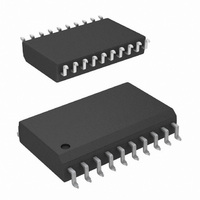LM1973MX/NOPB National Semiconductor, LM1973MX/NOPB Datasheet - Page 7

LM1973MX/NOPB
Manufacturer Part Number
LM1973MX/NOPB
Description
IC AUDIO ATTENUATR W/MUTE 20SOIC
Manufacturer
National Semiconductor
Type
Audio Attenuatorr
Datasheet
1.LM1973MNOPB.pdf
(12 pages)
Specifications of LM1973MX/NOPB
Applications
Consoles, MIDI
Mounting Type
Surface Mount
Package / Case
20-SOIC (7.5mm Width)
Pin Count
20
Screening Level
Commercial
Package Type
SOIC W
Lead Free Status / RoHS Status
Lead free / RoHS Compliant
Other names
*LM1973MX
*LM1973MX/NOPB
LM1973MX
*LM1973MX/NOPB
LM1973MX
Application Information
INPUT IMPEDANCE
The input impedance of a µPot is constant at a nominal
40 kΩ. To eliminate any unwanted DC components from
propagating through the device it is common to use 1 µF
input coupling caps. This is not necessary, however, if the dc
offset from the previous stage is negligible. For higher per-
formance systems, input coupling caps are preferred.
OUTPUT IMPEDANCE
The output of a µPot varies typically between 25 kΩ and
35 kΩ and changes nonlinearly with step changes. Since a
µPot is made up of a resistor ladder network with a logarith-
mic attenuation, the output impedance is nonlinear. Due to
this configuration, a µPot cannot be considered as a linear
potentiometer, but can be considered only as a logarithmic
attenuator.
It should be noted that the linearity of a µPot cannot be
measured directly without a buffer because the input imped-
ance of most measurement systems is not high enough to
provide the required accuracy. Due to the low impedance of
the measurement system, the output of the µPot would be
loaded down and an incorrect reading will result. To prevent
loading from occurring, a JFET input op amp should be used
as the buffer/amplifier. The performance of a µPot is limited
only by the performance of the external buffer/amplifier.
MUTE FUNCTION
One major feature of a µPot is its ability to mute the input
signal to an attenuation level of 104dB as shown in Figure 3.
This is accomplished internally by physically isolating the
output from the input while also grounding the output pin
through approximately 2 kΩ.
FIGURE 6. Mono Level Control with Panning Circuit
FIGURE 7. Serial Data Format Transfer Process
(Continued)
01195808
7
The mute function is obtained during power-up of the device
or by sending any binary data of 01001111 and above (to
11111111) serially to the device. The device may be placed
into mute from a previous attenuation setting by sending any
of the above data. This allows the designer to place a mute
button onto his system which could cause a microcontroller
to send the appropriate data to a µPot and thus mute any or
all channels. Since this function is achieved through soft-
ware, the designer has a great amount of flexibility in con-
figuring the system.
DC INPUTS
Although the µPot was designed to be used as an attenuator
for signals within the audio spectrum, the device is capable
of tracking an input DC voltage. The device will track DC
voltages to a diode drop above each supply rail.
One point to remember about DC tracking is that with a
buffer at the output of the µPot, the resolution of DC tracking
will depend upon the gain configuration of that output buffer
and its supply voltage. It should also be remembered that the
output buffer’s supply voltage does not have to be the same
as the µPot’s supply voltage. This could allow for more
resolution when DC tracking.
SERIAL DATA FORMAT
The LM1973 uses a 3-wire serial communication format that
is easily controlled by a microcontroller. The timing for the
3-wire set, comprised of DATA-IN, CLOCK, and LOAD/
SHIFT is shown in Figure 2. Figure 9 exhibits in block
diagram form how the digital interface controls the tap
switches which select the appropriate attenuation level. As
depicted in Figure 2, the LOAD/SHIFT line is to go low at
least 150 ns before the rising edge of the first clock pulse
and is to remain low throughout the transmission of each set
of 16 data bits. The serial data is comprised of 8 bits for
channel selection and 8 bits for attenuation setting. For both
address data and attenuation setting data, the MSB is sent
first and the 8 bits of address data are to be sent before the
8 bits of attenuation data. Please refer to Figure 7 to confirm
the serial data format transfer process.
www.national.com
01195809











